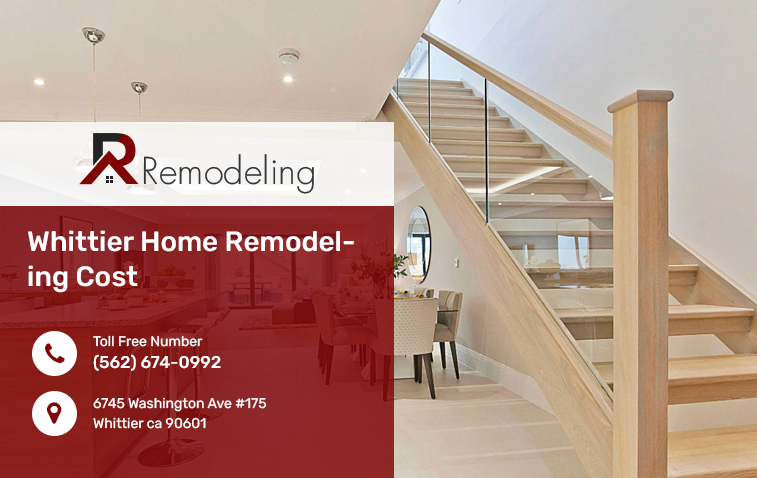- 6745 Washington Ave #175 Whittier CA 90601
Factors That Impact Whittier Home Remodeling Costs
Explore the key factors influencing home remodeling costs in Whittier. Dive into how project scope, timeline, labor and material costs, and plumbing and electrical work can significantly impact your budget, ensuring you make informed decisions.
When it comes to home remodeling, everyone wants a beautiful and functional living space that reflects their style. However, transforming your home can come at a cost, and understanding what factors impact these costs is crucial to planning and budgeting for your project. In this blog post, we will closely examine the various elements that influence Whittier home remodeling cost.

Project Scope
The scope of your project refers to your specific goals and objectives for your home renovation. Do you want to update a single room, such as a bathroom or kitchen, or are you looking to remodel your entire house? The size and complexity of your project will directly impact the cost as it will require more time, materials, and labor.
Before starting, a clear idea of your project scope is essential, as it will prevent any unexpected costs or delays. The scope of your project can broadly be divided into three categories:
- Minor Remodeling: This usually involves making small updates to a single room, such as repainting walls, changing light fixtures, or updating hardware. These changes are typically less expensive and can be completed quickly.
- Major Remodeling involves more substantial changes to a room or multiple rooms. It could include installing new cabinets in the kitchen, replacing a bathtub in the bathroom, or adding new flooring throughout the house. Significant projects require more time and resources and, hence, cost more.
- Full House Remodeling: This is the most extensive and costly type of remodeling. It involves significant changes to the entire house, including altering the layout, replacing the plumbing or electrical system, and possibly even making structural modifications. A full house remodel requires extensive planning, a budget, and a longer timeline.
Timeline
Another factor that affects the cost of remodeling is the timeline for completing the project. The longer your project takes, the more labor and materials are required, significantly impacting the overall cost. Furthermore, unforeseen delays in construction or delivery of materials can add up and cause your project’s timeline to extend beyond the initial estimate.
Here are common reasons that could cause a project to extend beyond the initially estimated period:
- Unpredicted Repair Work: Often, when renovating, specific issues that were not initially apparent, such as structural problems or dampness, are unearthed. These unforeseen complications necessitate additional repair work, extending the project’s timeline and increasing costs.
- Change in Scope: If the project scope changes midway, it can lead to a delay. For instance, upgrading all appliances after the kitchen renovation has already started can increase the timeline.
- Material Delivery Delays: There could be instances when necessary materials are delayed due to unforeseen situations, such as supply chain issues. This could cause the project to take longer than initially planned.
- Permit Delays: In some remodeling cases, specific permits are required. If those permits take longer to obtain, it could delay the overall timeline and increase costs.
At R Remodeling, we stay on schedule and budget, communicating with our clients every step to ensure a smooth and successful project.
Labor and Material Costs
Labor and material costs are the most significant factors impacting Whittier home remodeling costs. Labor costs vary depending on the type of work and the experience of the contractors involved. Skilled and experienced contractors may charge more, but they also tend to produce higher-quality work.
The cost of materials can vary greatly depending on availability, quality, and the quantity needed for your project. It’s always a good idea to shop around and compare prices from different suppliers to ensure you are getting the best value for your money.
Materials can be further broken down into a few categories:
- Economical Materials: These are affordable and easily accessible materials that can help keep your budget under control. Economical materials include laminate countertops, vinyl flooring, and stock cabinets. While they may not be as durable or luxurious as more expensive materials, they can still provide an appealing and functional finish.
- Mid-Range Materials: Mid-range materials are a step up from economical ones and balance cost and quality. This category includes hardwood flooring, quartz countertops, and semi-custom cabinets. They are more durable and aesthetically pleasing than economical materials but are still reasonably priced.
- High-End Materials: High-end materials are the most expensive, durable, and attractive. These materials include marble countertops, hardwood cabinets, and designer fixtures. While they can significantly increase your remodeling costs, they can also greatly enhance the look and feel of your home.
Labor also has its categories based on skill level and type of work:
- Basic Labor: Basic labor typically involves simple tasks that do not require specialized skills, such as painting walls or installing hardware. Although this type of labor is relatively inexpensive, it is crucial to the success of your project.
- Skilled Labor: Skilled labor involves tasks that require specific skills and training, such as plumbing, electrical work, or installing cabinets. This type of labor is more expensive than basic labor but is necessary for more complex remodeling projects.
- Specialized Labor: Specialized labor involves tasks that require a high level of expertise, such as installing custom fixtures or performing structural alterations. This type of labor is typically the most costly, but it can significantly enhance the quality and value of your project.
The key to managing labor and material costs is meticulous planning and budgeting. A clear understanding of what you want and need for your project can help you choose the right contractors and materials, control your costs, and ensure a successful project.

Plumbing and Electrical Work
Plumbing and electrical work are essential to home remodeling and can significantly impact overall costs. These tasks require specialized knowledge and skills, often at a higher cost. Additionally, updating plumbing or electrical systems might require obtaining permits, inspections, and meeting specific building codes, all of which can add to the project’s cost.
Some more factors to consider when factoring in the costs of plumbing and electrical work for your home remodeling include:
- The Type of Work Needed: The type of work needed directly impacts the cost. Rewiring a house or installing new plumbing lines is more complex and expensive than straightforward tasks like installing new fixtures or repairing leaks.
- Age of the House: Older homes often need more extensive electrical and plumbing work due to outdated systems, which may be incompatible with modern appliances or not up to current building codes.
- Location of the Plumbing and Electrical Systems: If the systems are complex to access, it could increase the workload and cost.
- Permit and Inspection Costs: Depending on the local regulations, you might need permits and inspections when altering your home’s plumbing and electrical systems. These costs should be factored into your remodeling budget.
- Emergencies and Surprises: Always have a contingency budget for unexpected issues. Once you start the project, you may uncover problems that need immediate attention.
When planning a remodeling project in Whittier, consider these factors and get a comprehensive quote before starting the work. Feel free to reach out for any queries at (562) 674-0992. We are committed to providing precise, accurate estimates and ensuring your remodeling is successful.
Conclusion
The cost of Whittier home remodeling can vary significantly depending on several factors. The project scope, timeline, labor and material costs, and plumbing and electrical work are major elements impacting the overall cost. However, with careful planning and budgeting, you can keep these costs under control and achieve your dream home within your budget.
Providing Award winning Home Remodeling Contractors in Whittier
At R Remodeling, we take care of all your remodeling needs. Click on the button below to get in touch with us now!
CONTACT USCopyright 2020 © R Remodeling.com

